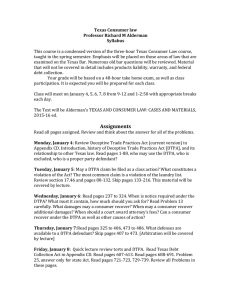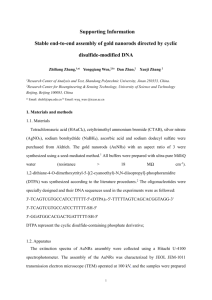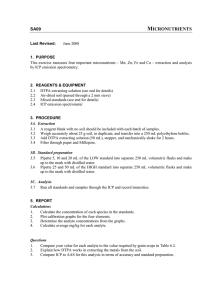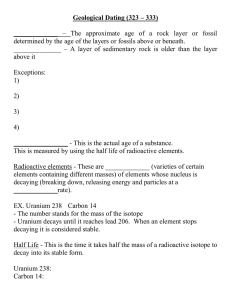“ Medical Management of Radionuclide Internal Contamination
advertisement
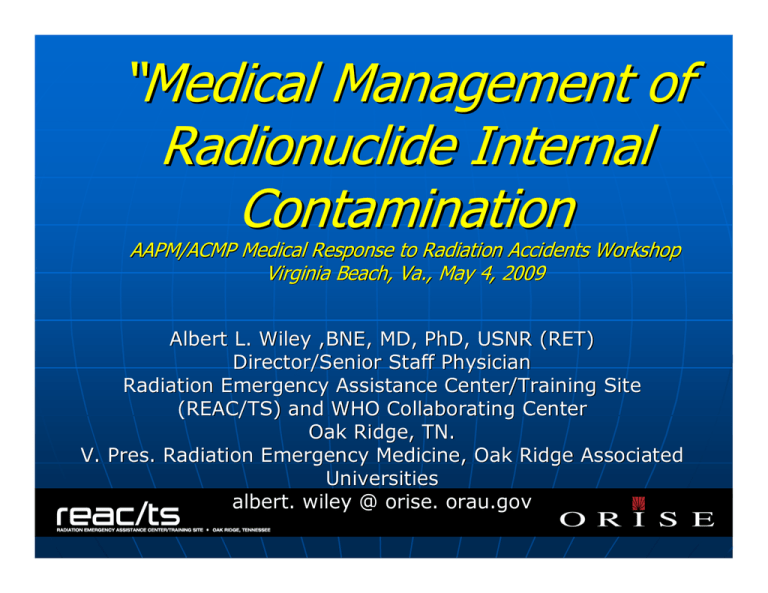
“Medical Management of Radionuclide Internal Contamination AAPM/ACMP Medical Response to Radiation Accidents Workshop Virginia Beach, Va., May 4, 2009 Albert L. Wiley ,BNE, MD, PhD, USNR (RET) Director/Senior Staff Physician Radiation Emergency Assistance Center/Training Site (REAC/TS) and WHO Collaborating Center Oak Ridge, TN. V. Pres. Radiation Emergency Medicine, Oak Ridge Associated Universities albert. wiley @ orise. orau.gov OBJECTIVES Discuss the body’s mechanisms for the internalization of radionuclides Discuss the procedures for treatment of internal contamination and methods for assessing the efficacy of that treatment Internal contamination is the deposition of radioactive material inside the body Other Terms Intake – merely crossing the 3-D confines of the human body Uptake – movement inside the body Incorporation – taken into the active metabolism of some cell, tissue or organ Decorporation – removal from the cell, tissue, organ or body Common Routes of Entry Inhalation Ingestion Percutaneous or transdermal absorption through skin Injection or puncture Percent Deposited Uptake of Actinides is Remarkably Rapid 100 80 60 Bone Deposition 40 20 0 0 1 Time (Hours) 2 Prompt DTPA Treatment of 239Pu Intake is Highly Effective Retention (% of Uptake) Liver Skeleton Control 14.0 57.0 DTPA Treated 0.47 5.9 Prompt KI Treatment of Intake is Highly Effective Thyroid Uptake, % 131I 0 15 30 6 12 18 24 Time of administration post-exposure, hours When to Treat? ALI (annual limit of intake) is that CEDE necessary to give 5 rem = 0.05 Sv For intake < 1 ALI, no treatment For 1< intake < 5 ALI, probably no treatment, with physician discretion For 5 < intake < 10 ALI, consider treatment For intake >10 ALI, treat with patient consent The “University Seven” H -3 C-14 P-32 Co-60 I-125 I-131 Cf-252 The “Industrial Three” Ir-192 Cs-137 Co-60 The “Military Three” U-235 Pu-239 Am-241 General Health Physics Guidelines Attempt to determine the maximum credible accident – incident history/reconstruction Inhalation: o Nasal swab taken within 1-2 hrs post-exposure can aid in nuclide identification and can approximate 5%-10% of intake. o Prepare for whole-body and/or lung counting Wounds: o Use of a wound probe helpful to ascertain maximum credible accident o Surgical debridement sometimes helpful if decontamination efforts are unsuccessful Immediate Diagnosis Incident history/reconstruction with health physics input are absolutely essential Wound surveys Facial surveys Nasal swipes Nasal blows Sputum Spot urine – check for gammas Methods for Assessing Intakes Whole Body Counting: o Feasible for nuclides that emit penetrating x or gamma rays o Useful also for nuclides emitting energetic beta particles - can be detected by their bremsstrahlung radiation Bioassay: o Urine - most widely used o Feces o Excised material from wounds Chromosome aberration analysis Bioassay Slow Must have total collection of both urine and feces May overestimate uptake by factor of 3-5 Specimen may get contaminated Whole Body Counting Difficult When Actinides Involved Residual skin contamination Calibration of phantoms difficult Lung distribution varies with time Variable thickness of chest wall Clearance Time - Nasopharynx Time to Swallowing Anterior Nares Nasopharnyx Approx. 60 min. 10 min. [10 mm/min.] Clearance Time of Respiratory Tract Time Trachea 0.1 hours Bronchi 1 hours Bronchioles 4 hours Terminal Bronchioles 10 hours Alveoli 100 Days + Inhalation Pathway Size of the aerosol particles determine region of the respiratory tract where most are deposited Fate of inhaled particles is dependent on their physico-chemical properties Highly insoluble particles remain in the lung for long periods of time o A small fraction will be transported to the tracheo-bronchial lymph nodes by pulmonary macrophages o Some are cleared through the airways, swallowed, and excreted in the feces Particle Size Distribution in the Respiratory Tree Mass Median Diameter [microns] 18-20 15-18 7-12 4-6 (bronchioles) 1-5 (alveoli) Clearance Time of Gastrointestinal Tract Stomach Small Intestine Upper Large Intestine Lower Large Intestine Occupancy Time [hours] 6 14 18 22 Absorption of Ingested Radionuclides Group Radioactive Elements of % Absorbed Alkali Metals Na, K, Rb, Cs High ~90 Group VIII Metals Fe Co Ru 10 30-90 3 Absorption of Ingested Radionuclides Group Radioactive Elements of % Absorbed Lanthanides Ce, Pm, Eu, Tb <0.1 Actinides Th, U, Np, Pu <0.1 The SC 4-1 document will provide many hypothetical case examples of diagnostic and operational guidelines for care of patients ,such as follows: A chemist at a Pu processing facility is involved in a loss of containment accident involving Pu239 oxide His nasal swabs read approximately 1,000 dpm total alpha bilaterally (500 dpm each nostril) Total nasal =5% of deep deposition (LLNL, ICRP 30 methodology) Estimated deep lung deposition is therefore approximately 20,000 dpm = 333 Bq Magnitude of the Problem 1 Ci = 37 X 109 Bq (37 GBq); 1 nCi=37 Bq Estimated lung deposition = 333 Bq ALI for Pu-239 is 6 X 10-4 MBq = 600 Bq (EPA FGR #11) So, estimated deposition is approximately 0.5 ALI Treatment Methods Minimize intake Reduce and/or inhibit absorption Block uptake Use isotopic dilution Promote excretion Alter chemistry of the substance Displace isotope from receptors Chelate Displace Use calcium to compete with radiostrontium Use stable iodide to compete with radio-technetium Chelate DTPA – Diethylenetriaminepentaacetic Acid EDTA – Versene BAL – Dimercaprol DFOA – Deferoxamine PCA - Penicillamine Reduction of Absorption From Gastrointestinal Tract Antacid Precipitation into insoluble salt Catharsis Prussian Blue is Highly Effective in Rx of Radio-Cesium or Thallium Uptake* Binds ions in gut Reduces biological half-life to one third of untreated value Not absorbed Reduces recycling (enterohepatic circulation) *Complete package information available at www.orau.gov/reacts/resources.htm Cesium 137Cs (physical half-life, 30 years; biological half-life 109 days) is the dominant radioisotope in aged fission products Distributes in body fluids similarly to potassium One gram orally three times daily x 3 weeks reduces the biological half-life to about 1/3 of the normal value (low ALI). For higher intake, titrate upward Saturate the Critical Organ with the Stable Isotope Thyroid 131I STOP Stable Iodine Nuclear Incidents In the immediate vicinity of a nuclear accident (the near field), exposure could begin immediately if the released plume is at a low level. Main route of exposure is inhalation. Potentially larger thyroid doses might be expected from radioiodine. Further away from the site of the accident (the far field), the main route of exposure to radioiodine would be ingestion of contaminated food and drink, particularly milk. Exposure by these routes could last longer, cover a larger area, and affect a larger population than exposure in the near field. Iodine The dominant initial internal contaminant after a reactor accident, nuclear weapons test, or any incident involving fresh fission products is likely to be 131I. Thyroid is generally blocked by dilution; 130 mg KI tablet stat and one tablet daily x 7-14 days. 5 or 6 drops of SSKI, Saturated Solution of Potassium Iodide (1 g/ml) is another convenient way to administer stable iodide. Potassium perchlorate (200 mg) may be used in patients with iodine sensitivity. Dose of Stable I to Exposed Groups Consider a basic tablet giving 50 mg of I Adults: two tablets Children and adolescents: one tablet. Infants: 1/2 tablet Neonates: 1/4-1/2 tablet crushed up in jam or a drink Timing: ASAP. In a situation with continuing exposure, stable I may be 50% effective even 5 hours after exposure to radioiodine. Rubery and Smales. Iodine Prophylaxis Following Nuclear Accidents. 1988. FDA Recommendations for Potassium Iodide Group Daily Dose [mg] Infants <1 month 16 Children 1 month – 3 years 32 Children and teenagers 3 – 18 years 65 Adults 130 (including pregnant and lactating women and adolescents over 150 pounds) Daily dosing should continue until the risk of exposure has passed and/or until other measures (evacuation, sheltering, control of the food and milk supply) have been successfully implemented Exposed Population Groups Pregnant women o First trimester - In the near field, stable I will protect mother; no fetal action necessary. In the far field, maternal protection may be effected by controls on food. o Second trimester - Fetal thyroid begins to function around the 12th week of gestation. Stable I should be given for subjects in both near and far fields to protect maternal and fetal thyroids. o Third trimester - Same as 2nd trimester. Conclusions: Stable I to all pregnant women in near field for all trimesters; stable I to 2nd and 3rd trimester women in the far field. (Rubery and Smales, 1988). Tritium - 3H Follows pathway of water in the body Penetrates skin, lungs, and GI tract, either as tritiated water (HTO) or in the gaseous form Single exposures are treated by forcing fluids This has the dual value of diluting the tritium and increasing excretion Biological half-life - 10 days Forcing fluids to tolerance (3-4 L/d) will reduce the biological half-life to 1/3 to 1/2 of the normal value Isotopically Dilute Tritium NCRP 65 Rule of Thumb 1 µCi/L of urine equates to 10 mrem whole body dose (conservative) Five teens steal a H-3 exit sign and open it in an enclosed basement bedroom Highest urine activity is approximately 5.8 µCi/L Maximum estimate of CEDE is 58 mrem Strontium (Sr-90) Strontium-90 (Sr-90) is a by-product of the nuclear fission process, as found in nuclear power reactors or nuclear weapons Sr-90 could be used by terrorists to create a radiological dispersal device (RDD or “dirty bomb”) It could also be released as the result of a catastrophic event at a nuclear power plant Medical countermeasures include aluminum phosphate, aluminum hydroxide, barium sulfate, IV calcium gluconate, sodium alginate Actinides Plutonium, Americium, Curium, and Californium All have long biological half-lives Inhalation is approximately 75% of industrial exposures If the compound is soluble (nitrate, citrate, fluoride), compound is ultimately translocated from the lungs to ultimate disposition sites (bone and liver) Ca-DTPA and Zn-DTPA chelation therapy is the treatment of choice DTPA Trisodium calcium diethylenetriaminepentaacetate (Ca-DTPA) Chelating agent for transuranic elements Ca-DTPA is approximately 10 times more effective than Zn-DTPA for initial chelation of transuranics It is the treatment of choice for initial patient management Must be given as soon as possible after accident After 24 hours, Ca-DTPA and Zn-DTPA are essentially equally effective Repeated dosing of Ca-DTPA can deplete the body of zinc and manganese Clinical Pharmacology of DTPA DTPA belongs to the group of synthetic polyamino polycarboxylic acids which form stable complexes (metal chelates) with a large number of metal ions DTPA o exchanges calcium (zinc) for another metal of greater binding power o Chemical complex then excreted by the kidneys o The plasma half-life of DTPA is 20-60 minutes. o DTPA undergoes only a minimal amount of metabolic change Clinical Pharmacology of DTPA DTPA o No accumulation of DTPA in specific organs has been observed o promptly cleared from the body by glomerular filtration o Ca-DTPA can deplete the body of zinc and, to a lesser extent, manganese with repeated dosing o Ca-DTPA is approximately 10 times more effective than Zn-DTPA for initial chelation of transuranics DTPA Dosing Schedules Dosage of Ca-DTPA and Zn-DTPA is 1 gm IV or inhalation in a nebulizer (1:1 dilution with water or saline) Very safe drug with no significant adverse reactions noted during 25 years of usage Initially: 1 gm Ca-DTPA; repeat 1 gm Zn-DTPA daily up to five days if bioassay results indicate need for additional chelation Ca-DTPA - Pregnancy category D; Zn-DTPA Pregnancy category C DTPA + DFOA may be a better combination DTPA - Relative Contraindications Pregnancy - Use first dose as Zn-DTPA instead of Ca-DTPA Diabetic on Insulin - Use Zn-DTPA and monitor glucose levels Depressed myelopoietic function - clinical judgment Impaired renal function - clinical judgment Children - no data available How to Administer DTPA* IV injection of DTPA (1 gm/4ml) with 6 ml saline over 5-10 minutes IV Piggyback (1 gm DTPA in 100ml saline) over 20 minutes Aerosol: 1 gram undiluted via hand-held nebulizer; inhalation takes 10-15 minutes IM injection (painful) Under 18 YOA, use zinc-DTPA Monitor magnesium and other electrolytes routinely *Complete package information available at www.orau.gov/reacts/resources.htm Uranium Solubility classes: o UF6 (uranium hexafluoride): Class D (days) o UO2(NO3)2 - Uranyl nitrate: Class D o UO2 - Uranium dioxide: Class W,Y (weeks, years) o UO2 - High-fired Uranium dioxide: Class Y Inhalation is usual occupational exposure Overall biological half-life of 15 days 85% of retained U resides in bone Kidney toxicity is the basis of occupational exposure limits Uranium In acidic urine, uranyl ion complex with tubule surface proteins Some of the bound UO22+ is retained in the kidney Kidney is the first organ to show chemical damage in the form of nephritis and proteinuria Oral doses or infusions of sodium bicarbonate are the US treatment of choice and should be dosed to keep the urine alkaline by frequent urine pH checks Recent Clinical Research I - Uranium Henge-Napoli have evaluated the efficacy of ethane-1-hydroxy-1,1 bisphosphonate (EHBP, Etidronate, Didronel®) in experiments to obtain compounds that will reduce the fixation of uranium in its main target organs of bone and kidney One injection of EHBP (50-100 micromol/kg), given acutely after uranium inhalation in animals, reduced uranium deposition in the renal system by a factor of five, and still a factor of two when given 30 minutes post-exposure Recent Clinical Research II - Uranium In another series of animal experiments, Destombes, et al, compared the carbonic anhydrase inhibitor, acetazolamide (Diamox ), with bicarbonate in the treatment of internal contamination with uranium Acetazolamide is three times more effective than bicarbonate in reducing the renal content of uranium, but has no effect on skeletal content Uranium Urine Alkalinization: Sodium bicarbonate IV dosage: 1 mEq/kg/day IV with 10-20 mEq KCl to maintain urine at pH >7.5 Oral dosage: from the 1979 NCRP 65 but probably not to be recommended in 2009. Adults: Initially, 1-10 mEq/kg/day or 4 g PO then 1-2 g every 4 hours. Titrate dosage based on urinary pH. Children: 1-10 mEq/kg/day (84-840 mg/kg/day) PO, given in divided doses every 4-6 hours. Titrate dosage based on urinary pH. May need renal dialysis until renal recovery from injury. Good References NCRP 65: Management of Persons Accidentally Contaminated with Radionuclides (April, 1980) but ,NCRP SC 4-1 is updating and expanding NCRP 65 to be reissued as NCRP 161 in 2009 . EPA Federal Guidance Report #11: Limiting Values of Radionuclide Intake and Air Concentration and Dose Conversion Factors for Inhalation, Submersion and Ingestion (EPA-520/1-88-020, Sept., 1988) Thank You for Your Attention! Questions? albert .wiley@orise.orau.gov re a c /t s
